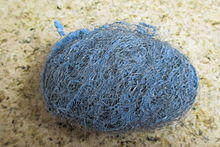S.O.S Soap Pad is a trade name for an abrasive cleaning pad, used for household cleaning, and made from steel wool saturated with soap.
In 1917, Irwin Cox of San Francisco, California, an aluminum pot salesman, invented a pre-soaped pad with which to clean pots. As a way of introducing himself to potential new customers, Cox made the soap encrusted steel-wool pads as a calling card. His wife named the soap pads S.O.S or "Save Our Saucepans." Cox soon found out that the S.O.S pads were a hotter product than his pots and pans.[1]
It is commonly believed that an error was made in the name's punctuation. However, this spelling was chosen by design. The acronym, S.O.S., is the famous distress signal and could not be trademarked. By removing the last period, the name was unique and could then be registered with the United States Patent and Trademark Office.[2]
The product was indirectly featured in a widely circulated black & white photograph taken by William Safire of the Kitchen Debate. One of its boxes is clearly visible on the right side of the picture, standing on the countertop above the washing machine.[3]
It was later bought by General Foods, then by the late 1960s was sold to Miles Laboratories. In the mid-1990s, the manufacturer began advertising that S.O.S pads had been made rust-resistant. In fact the pads were so well-protected against rust, and the pads lasted so much longer, that Miles removed the rust-inhibiting ingredients and ceased to advertise the pad's rust resistant quality. Later, Miles sold the brand to Clorox.
See also
References
- ^ SOS History
- ^ About the name
- ^ Safire, William (July 24, 2009). "The Cold War's Hot Kitchen". The New York Times.
